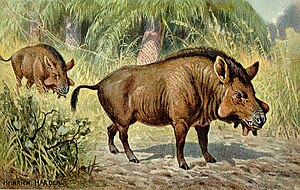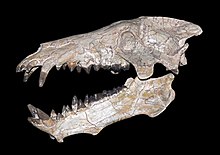Entelodontidae
| Entelodontidae | ||||||||||||
|---|---|---|---|---|---|---|---|---|---|---|---|---|

Live image of Entelodon . Illustration made by Heinrich Harder around 1920 |
||||||||||||
| Temporal occurrence | ||||||||||||
| late Eocene to early Miocene | ||||||||||||
| 38 to 19 million years | ||||||||||||
| Locations | ||||||||||||
| Systematics | ||||||||||||
|
||||||||||||
| Scientific name of the superfamily | ||||||||||||
| Entelodontoidea | ||||||||||||
| Lydekker , 1883 | ||||||||||||
| Scientific name of the family | ||||||||||||
| Entelodontidae | ||||||||||||
| Lydekker , 1883 | ||||||||||||
The Entelodontidae are an extinct group of pigs (Suina) that appeared in Asia 38 million years ago in the late Eocene , later colonized Europe and North America and became extinct in the early Miocene .
features

The entelodons had massive bodies with large, wide, and low skulls. The skull of the largest forms, such as the European Entelodon and Archaeotherium from North America, could reach a length of one meter. The thoracic vertebrae had long spinous processes . The neck was short and sturdy, the tail short. Entelodonts had complete, bunodontal dentition, which is untypical for cloven-hoofed animals, and which is more comparable to that of the Condylarthra , Mesonychia and Arctocyonidae .
The scientific name of the group is derived from the teeth ( Gr .: enteles = complete; odontos = tooth). The bunodonte dentition is typical for omnivores . The tooth formula is 3-1-4-3 / 3-1-4-3.
Further features of the family are the rope-shaped ankle bone , long legs and a didactyl foot, in which the body weight rested on the third and fourth toes. The zygomatic arch was characterized by a bony outgrowth formed exclusively by the zygomatic bone . The lower jaw also had at least one pair, but more often two pairs of bony outgrowths on the underside.
Systematics
The entelodons likely share a common ancestor with pigs, who may have lived in Asia more than 38 million years ago. They are the sister group of the Suoidea ( real pigs and umbilical pigs ). In the past, in addition to the Entelodontidae, the Achaenodontidae were also placed in the superfamily Entelodontoidea. After the assignment of Achaenodon to the Helohyidae it is now monotypic . However, there is also the opinion that the Entelodontidae belong to the common group of whales and hippos , the so-called Cetancodontamorpha, and form their sister group.
Genera

A total of 23 genera and 56 species have been described in the last 155 years. Of the genera, the following are still considered valid today:
- Eoentelodon , Late Eocene of China
- Entelodon , early Oligocene of Europe
- Brachyhyops , Eocene of New Mexico
- Cypretherium , Saskatchewan Oligocene
- Archaeotherium , early Oligocene of North America
- Daeodon , Oligocene to Miocene of North America
- Paraentelodon , Georgia, Kazakhstan, China
literature
- Donald R. Prothero, Scott E. Foss (Eds.): The Evolution of Artiodactyls. Johns Hopkins University Press, Baltimore MD 2007, ISBN 978-0-8018-8735-2 .
Web links
Individual evidence
- ↑ Jordi Agusti, Mauricio Anton: Mammoths, Sabertooths, and Hominids: 65 Million Years of Mammalian Evolution in Europe. Columbia University Press, 2005, pp. 74-77 ISBN 978-0-231-11641-1
- ↑ Jonathan H. Geisler, Jessica M. Theodor: Hippopotamus and whale phylogeny. Nature 458, 2009, pp. E1-E4.
- ↑ Margery C. Coombs, Walter P. Coombs Jr .: Dentition of Gobiohyus and a reevaluation of the Helohyidae (Artiodactyla). Journal of Mammalogy 58 (3), 1977, pp. 291-308
- ↑ Ismael Ferrusquía-Villafranca: The first Paleogene mammal record of Middle America: Simojovelhyus pocitosense (Helohyidae, Artiodactyla). Journal of Vertebrate Paleontology 26 (4), 2006, pp. 989-1001
- ↑ Michelle Spaulding, Maureen A. O'Leary, John Gatesy: Relationships of Cetacea (Artiodactyla) Among Mammals: Increased Taxon Sampling Alter Interpretations of Key Fossils and Character Evolution. PLoS ONE 4 (9), 2009, p. E7062, doi: 10.1371 / journal.pone.00070622009 .